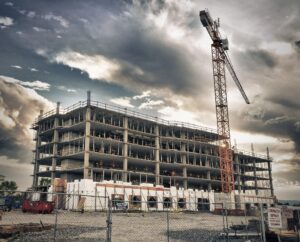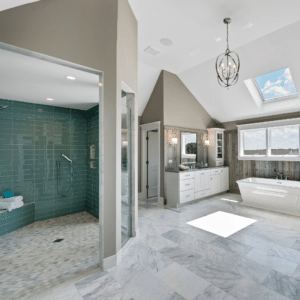When designing a skyscraper, one of the biggest challenges is ensuring the structure can support immense weight while maximizing interior space. Without the right framework, buildings can become unstable or inefficient. In this article, we’ll explore the best skeletal steel structures for skyscraper construction to help you understand how to build safer, stronger high-rises.
The best skeletal steel structures for skyscraper construction include the rigid frame system, known for its load-bearing capacity; the bundled tube system, which provides strength through multiple columns; and the diagrid system, which allows for innovative design flexibility while maintaining structural integrity.
- The Spooky Beginnings of Steel Structures: How Skeletons Transformed the Skyline
- Steel Structures for Skyscraper Construction: What Makes Them So Effective?
- Rigid Frame Systems: The Unshakable Skeleton Behind the World’s Tallest Towers
- Bundled Tube Systems: A Spine of Steel That Defies Gravity
- Diagrid Systems: The Twisting, Turning Skeletons of Modern Skyscrapers
- The Future of Steel Skeletons: How Tomorrow’s Skyscrapers Will Rise from the Ground
- Building the Future: Harnessing the Power of Steel Structures for Iconic Skyscrapers
Key takeaway:
- Steel skeletons are the foundation of modern skyscrapers, offering stability and height that traditional materials couldn’t support.
- Steel is the most effective material for skyscraper construction due to its strength, flexibility, and sustainability, reducing both costs and environmental impact.
- The rigid frame system provides both stability and cost-efficiency, making it ideal for high-rise construction in areas prone to environmental forces.
- Bundled tube systems maximize interior space and height, offering a cost-effective solution for developers aiming to build taller, more flexible structures.
- Diagrid systems provide enhanced structural resilience while offering greater design flexibility, making them ideal for unique, modern skyscrapers.
- The future of skyscraper construction lies in sustainable, energy-efficient designs, with steel continuing to be the material of choice for developers.
These systems have shaped modern skylines, but there’s more to consider when selecting the right structure for your project. Keep reading to learn about the historical evolution of steel frameworks and how these systems can impact your next commercial development.
The Spooky Beginnings of Steel Structures: How Skeletons Transformed the Skyline
In the late 19th century, the rise of steel structures revolutionized architecture. Before steel, buildings were limited in height by the weight and strength of brick and stone. As cities grew, so did the demand for taller buildings, but conventional materials couldn’t support such heights. The introduction of steel “skeletons” changed that. These frameworks allowed for taller, more stable structures, transforming the urban skyline into the towering giants we recognize today. As a result, cities like Chicago and New York became testbeds for early skyscraper construction, with steel forming the backbone of their impressive growth.
Steel Structures for Skyscraper Construction: What Makes Them So Effective?
Steel structures for skyscraper construction offer unmatched strength, durability, and flexibility. Steel is highly resistant to stress, supporting both vertical and lateral loads, which makes it ideal for skyscrapers. It also provides design versatility, allowing architects to create large, open spaces without the need for interior columns. Additionally, steel is more sustainable than concrete, as it can be recycled and reused. In fact, according to the American Institute of Steel Construction, structural steel contains at least 93% recycled content and is fully recyclable, making it a circular material that can be reused for generations, aligning with long-term sustainability goals.
Rigid Frame Systems: The Unshakable Skeleton Behind the World’s Tallest Towers
The rigid frame system is a fundamental method in skyscraper construction due to its ability to support both horizontal and vertical loads. This structural system consists of interconnected beams and columns, forming a sturdy “skeleton” that effectively resists forces such as wind and seismic activity. Its ability to evenly distribute loads throughout the building reduces the need for additional materials, making it a cost-effective and reliable choice for high-rise construction. Developers seeking to balance strength, durability, and budget constraints find the rigid frame system to be an optimal solution for creating stable, long-lasting skyscrapers.
Bundled Tube Systems: A Spine of Steel That Defies Gravity
The bundled tube system, pioneered by architect Fazlur Khan, revolutionized skyscraper design by enabling buildings to grow taller and slimmer. This method involves a series of interconnected steel tubes that share the structural load, significantly reducing the need for internal supports. The system allows skyscrapers to reach greater heights while maximizing usable interior space, making it ideal for commercial developments. The Willis Tower is a prime example of this system in action, using a bundled tube design to reach its impressive height. The bundled tube system’s efficiency supports both structural integrity and innovative design, enabling the creation of visually striking skyscrapers without compromising strength.
Diagrid Systems: The Twisting, Turning Skeletons of Modern Skyscrapers
The diagrid system is an innovative structural method that offers both strength and architectural creativity. It uses diagonal steel beams to form a grid-like structure, which distributes weight evenly across the building’s surface. This method not only improves a building’s resilience to wind and seismic activity but also allows for eye-catching, non-traditional shapes. Buildings like The Hearst Tower in New York exemplify the artistic potential of diagrid systems. For developers looking to make a statement with their commercial properties, the diagrid system provides both strength and visual appeal.
The Future of Steel Skeletons: How Tomorrow’s Skyscrapers Will Rise from the Ground
As urbanization continues to grow, steel will remain essential in the future of skyscraper construction. New advancements in materials science are making high-strength, lightweight steel alloys more accessible, allowing buildings to reach greater heights with improved efficiency. Sustainability is also a key priority for developers, who are increasingly choosing steel structures that minimize environmental impact. The steel industry is making significant progress in this area; according to the American Iron and Steel Institute, there has been a 35% reduction in energy use and a 37% drop in greenhouse gas emissions since 1990. These innovations position steel structures for skyscraper construction to lead the next wave of sustainable and resilient urban architecture.
Building the Future: Harnessing the Power of Steel Structures for Iconic Skyscrapers
The evolution of steel structures for skyscraper construction has transformed modern architecture, enabling taller, stronger, and more efficient buildings. Whether you’re looking for cost-effective solutions like rigid frame systems or innovative designs with diagrid structures, steel remains the backbone of sustainable, high-rise developments. For developers aiming to shape the future skyline, choosing the best skeletal steel structures for skyscraper construction is key to success.
Ready to bring your next skyscraper project to life with the strength and innovation of steel structures? Contact Guzzo Architects today at 201-939-1446 to discover how our expertise in commercial architecture can help you create high-quality, sustainable buildings that stand the test of time.
What are the cost benefits of using steel structures for skyscraper construction?
Steel structures offer long-term cost benefits by reducing material waste, labor time, and maintenance costs. Steel’s durability and strength require fewer repairs over the building’s lifespan, and its recyclability makes it a sustainable option. Additionally, steel allows for quicker assembly, leading to faster project completion and reduced labor expenses.
How do steel structures contribute to sustainability in skyscraper construction?
Steel is one of the most recyclable materials used in construction, with nearly 100% of structural steel being recyclable. Its longevity and strength reduce the need for frequent repairs, lowering the environmental impact of ongoing maintenance. Additionally, steel structures are compatible with energy-efficient building designs, contributing to lower overall energy consumption.
What are the safety advantages of steel structures in skyscrapers?
Steel structures provide excellent fire resistance and perform well under extreme weather conditions like earthquakes and high winds. Its flexibility allows buildings to sway without breaking, making it a safer option in seismic zones. Steel is also non-combustible, enhancing the safety of high-rise buildings in the event of a fire.








